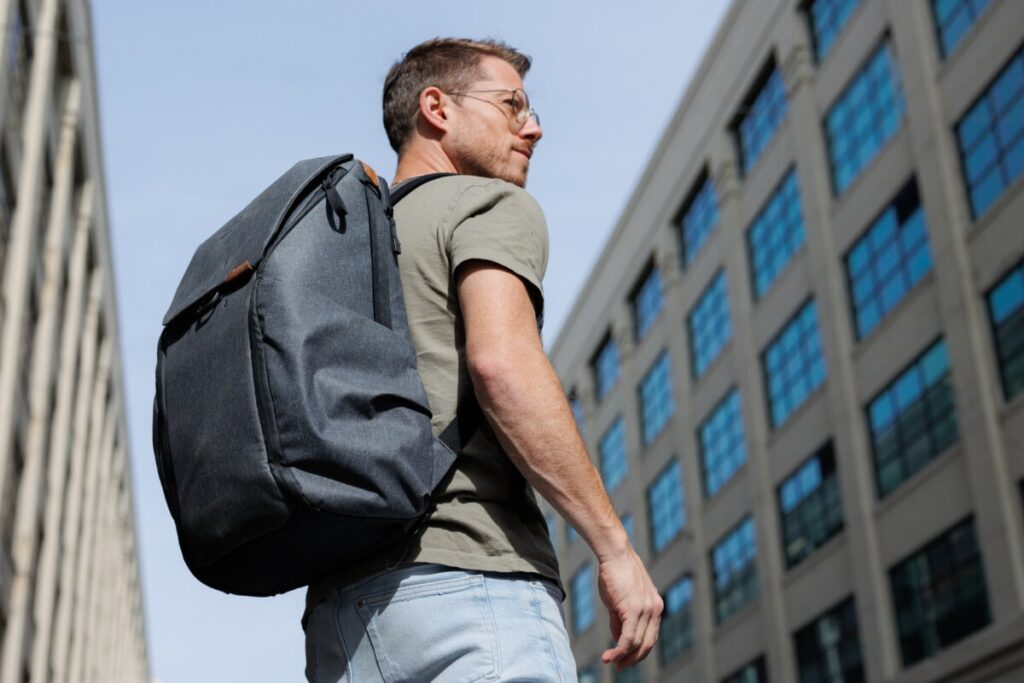Students, travelers, and outdoorsy folks have long relied on backpacks to carry their stuff. People use backpacks for everything from carrying a laptop to work to carrying mountaineering gear to the top of Everest.
Our team has spent decades researching, testing, and reviewing backpacks. We’ve built close relationships with many established and up-and-coming brands, and we keep a close watch on the industry. We built this report based on in-depth analysis of trends in the backpack industry.
The key takeaway from our research is that as people are living more on the go, backpacks are booming in popularity—a backpack really is the perfect tool for many modern lifestyles. Brands are responding to this trend and developing innovative backpack designs to cater to a variety of needs, from the urban commuter to the full-time digital nomad.
I’ll guide you through our in-depth research on the backpack market, top brands, and product categories.
Key Backpack Statistics
- From 2010 to 2019, US backpack sales increased over 170%.
- The global backpack market was valued at $15.9 billion in 2022 and is expected to grow to $31.38 billion by 2030.
- VF, the parent company that owns JanSport and The North Face accounts for over 55% of backpack sales in the US.
- The average carry-on backpack has 38.8 L of volume, weighs 3.4 lbs, and costs $237.00.
- The average everyday backpack has 22.2 L of volume, weighs 2.5 lbs, and costs $199.84.
- The average hiking daypack has 22.4 L of volume, weighs 1.5 lbs, and costs $145.58.
- The average multiday hiking backpack has 51.9 L of volume, weighs 4.5 lbs, and costs $289.81.
- The most common material for travel and everyday backpacks is midweight woven nylon or polyester.
- The most common material for hiking and outdoor backpacks is ripstop nylon.
Backpack Market Statistics
In the US and globally, the backpack market has seen tremendous growth over the past decades. More people are relying on backpacks for their daily lives and for recreation, and that is driving up backpack sales and incentivizing companies to invest more in back design and innovation.
Here are the key statistics for understanding the backpack market.
US Backpack Retail Sales Over Time
The United States has the largest market for backpacks worldwide, and despite setbacks due to COVID-19, that market is continuing to grow steadily.
The chart and table below show the total retail sales for backpacks in the US from 2010 to 2021.
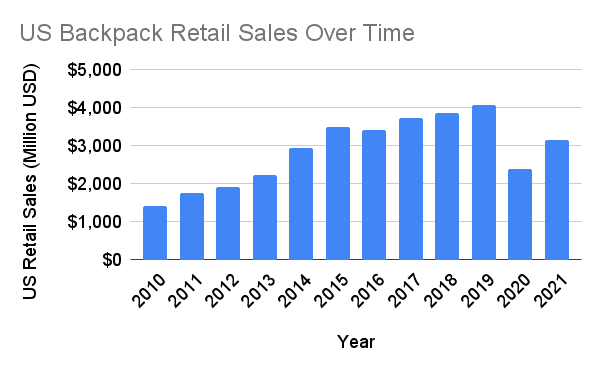
|
US Backpack Retail Sales Over Time |
|
|
Year |
Sales (Million USD) |
| 2010 |
$1,419 |
|
2011 |
$1,749 |
| 2012 |
$1,915 |
|
2013 |
$2,239 |
| 2014 |
$2,932 |
|
2015 |
$3,496 |
| 2016 |
$3,398 |
|
2017 |
$3,727 |
| 2018 |
$3,846 |
| 2019 |
$4,077 |
|
2020 |
$2,395 |
| 2021 |
$3,136 |
The data above shows a tremendous growth rate in the US backpack market. From 2010 to 2019, US backpack sales increased by over 170%.
Unsurprisingly, there was a major drop in backpack sales during 2020 as COVID-19 put a halt to travel and shut down schools. By 2021, US backpack sales were already back to 76% of the pre-COVID high, and that trend is only expected to continue as more and more people in the US are traveling or getting outside.
Global Backpack Market Size Forecast
In 2022, the global backpack was valued at $15.9 Billion, according to Statista.
The table below shows the forecasted growth of the backpack market worldwide, from 2022 to 2030.
|
Global Backpack Market Size Forecast |
|
|
Year |
Billion USD |
| 2022 |
$15.90 |
|
2023 |
$17.21 |
| 2024 |
$18.75 |
|
2025 |
$20.43 |
| 2026 |
$22.26 |
|
2027 |
$24.26 |
| 2028 |
$26.43 |
|
2029 |
$28.80 |
| 2030 |
$31.38 |
Clearly, the backpack industry is poised for massive growth over the next several years. This can be attributed to several factors:
- As adventure tourism and outdoor activities become increasingly popular in the US and around the globe, people need specialized backpacks designed for hiking, camping, biking, skiing, mountaineering, and more.
- 50 years ago, if you were headed into the office, you carried a briefcase. Today, as workplaces become more casual and less structured, backpacks are quickly becoming the norm. More brands are developing professional-looking laptop backpacks that fit in perfectly with the modern workplace.
- COVID-19 introduced the world to remote work on a massive scale, and more people than ever are choosing “digital nomad” lifestyles. A carry-on backpack is the perfect tool for traveling the globe while staying connected to the grid.
Global Backpack Google Search Interest by Month
The backpack market is highly seasonal. Distinct seasonal trends are apparent in both retail sales and internet search volume.
The table below shows worldwide Google Trends search interest in the term “backpack” by month from January 2021 to December 2023.
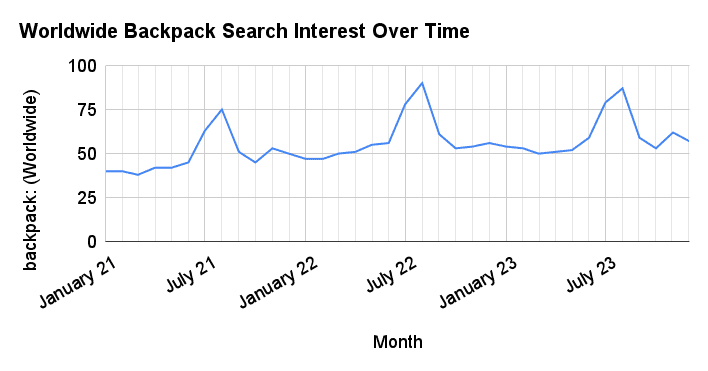
In the chart above, there is a distinct spike in Google search interest for backpacks every July-August. During this spike, searches for the term “backpack” jumps to over 170% of normal.
While puzzling at first, there is a very simple explanation for this seasonal spike: back to school.
It’s true that more and more people are buying backpacks for work, travel, and outdoor activities, but there’s no denying that students are the largest market for backpacks. From Kindergarten through college, students are the ones using a backpack all day, every day.
That isn’t likely to change anytime soon.
Of course, the back-to-school trend doesn’t hold for hiking or travel backpacks. These are more likely to be purchased in spring (at the start of travel and hiking seasons) or closer to the end of the year around the holidays and Black Friday.
Backpack Brand Statistics
As more people are buying backpacks for a variety of uses, the industry is becoming more competitive, with brands vying for market share.
A few brands, like JanSport, have become household names, but many smaller startups are beginning to make serious inroads in the market.
Here are the key backpack brand statistics from our research.
Top Backpack Brands by Google Search Volume
One way to compare the top backpack brands is by search volume. While this isn’t a perfect metric for revenue or number of backpacks sold, it is an accurate way to gauge the interest and brand awareness in a particular brand.
I did in-depth Google search analysis to find the brands with the highest search volume on Google. Because many of the brands sell more products than just backpacks (like Nike, for whom backpacks are merely an accessory product), I used search terms that include the word “backpack” or “backpacks” (whichever ranked higher).
The table below shows the top 20 backpack brands rated by Google search volume.
|
Top Backpack Brands by Search Volume |
||
|
Brand |
Monthly Search Volume | |
| 1 | Jansport |
191000 |
|
2 |
Nike | 90000 |
| 3 | The North Face |
83000 |
|
4 |
Lululemon | 52000 |
| 5 | Herschel |
40000 |
|
6 |
Patagonia | 35000 |
| 7 | Osprey |
34000 |
|
8 |
Carhartt | 33000 |
| 9 | Tumi |
29000 |
|
10 |
Adidas | 27000 |
| 11 | Gucci |
18000 |
|
12 |
Ogio | 18000 |
| 13 | Fjallraven |
17000 |
|
14 |
Cotopaxi | 15000 |
| 15 | High Sierra |
15000 |
|
16 |
REI | 10000 |
| 17 | NOMATIC |
9800 |
|
18 |
Timbuk2 | 8000 |
|
19 |
Dakine |
8000 |
| 20 | Beis |
7000 |
Interestingly, of the top 10 brands by search volume, only 3 specialize specifically in backpacks. Many of the top brands are apparel companies that have built out backpack product lines (Nike, Lululemon, and Adidas).
Within this top 20 list, there is a wide range of travel, urban, and outdoor brands.
The undisputed leader of the pack is JanSport, which has more than double the search volume of Nike backpacks in second place. This makes sense if you’ve spent much time in a school or college campus and paid attention to the backpack brands. That little JanSport patch is everywhere.
Top Backpack Brands by Category
Backpacks can be divided into three broad categories: everyday backpacks (which includes school, laptop, and commuting bags), travel backpacks, and outdoor backpacks. The table below shows the five most popular brands in each category.
| Everyday | Travel | Outdoor | |
| 1 | JanSport | Tumi |
The North Face |
|
2 |
Nike | Cotopaxi | Patagonia |
| 3 | The North Face | Nomatic |
Osprey |
|
4 |
Lululemon | Timbuk2 | Fjallraven |
| 5 | Herschel | Beis |
Cotopaxi |
Note that The North Face appears in both the everyday and outdoor backpack lists. While The North Face originally started as an outdoor gear company, it has broadened its product range to include a variety of daily carry backpacks for school, commuting, travel, and laptop carry. This brought the brand more into the mainstream.
It’s also worth noticing that JanSport and The North Face are both owned by the same parent company: VF, which also controls Timberland and Eastpak. Between its varied brands, VF accounts for 55% of backpack sales in the US, according to the New York Times.
Backpack Brand Factory Locations
I analyzed 82 of the world’s most popular backpack brands to find their factory locations and see how backpack manufacturing is distributed around the globe. Some brands own a single factory and perform all product assembly under one roof. Others contract out to dozens or even hundreds of factories around the world to make their products.
The chart below shows the percentage of brands that rely on factories in each region.
|
% of Brands by Factory Location |
|
| Asia-Pacific |
82.9% |
|
North America |
28.0% |
| Europe |
13.4% |
|
South America |
4.9% |
| Africa |
1.2% |
Unsurprisingly, Asia has the highest concentration of backpack manufacturing by far, with 82.9% of brands using manufacturing facilities in Asian countries. China, Vietnam, and the Philippines account for the majority of backpack manufacturing in Asia.
28% of brands have some manufacturing in the United States, while only 9.8% manufacture exclusively in the US. For many of these brands (like GORUCK and Hyperlite Mountain Gear), “made in the USA” is one of their major marketing claims.
Travel backpacks include packs that are designed to carry clothing and gear on trips by plane, train, bus, and car. While some travel backpacks are designed with comfortable harnesses for trekking, they also focus on features optimized for more urban travel.
Travel backpacks are used to replace more traditional luggage and are larger than daypacks. While many people use daypacks during travel, it is typically in addition to a larger bag.
Travel backpacks range from slim 30L personal-item-size bags to cavernous packs you’d have to check on a flight. Because our dataset has a low number of checked luggage-sized travel backpacks, I focused this analysis on carry-on backpacks, which are much more common.
Carry-On Travel Backpack Volume
The general consensus is that a travel backpack must have over 30 L of volume. Less than that, and it is a daypack.
The average carry-on backpack volume is 38.8 L, and 68% of carry-on backpacks are between 33.6 L and 44.0 L. The fact that the median is higher than the average indicates that travel backpack volume is slightly left-skewed, meaning that there is a high concentration of backpacks slightly above the average weight. This makes sense since 40L is a fairly standard carry-on backpack size.
At TravelFreak, we generally recommend 35-45L as a good size range for a carry-on backpack for most people. These data results show that backpack manufacturers also follow a similar guideline.
|
Carry-On Backpack Volume Statistics |
|
| Average |
38.8 L |
|
Median |
40 L |
| Standard Deviation |
5.2 L |
Carry-On Travel Backpack Weight
Backpack weight is also an important factor when buying a travel pack. Heavier bags are more tiring to carry and make it harder to stay under weight restrictions. That said, we think comfort and durability are more important than weight.
Our data shows that the average carry-on travel backpack weight is 3.5 lbs and that 68% of travel backpacks are between 2.7 lbs and 4.1 lbs.
|
Carry-On Backpack Weight Statistics |
|
| Average |
3.4 lbs |
|
Median |
3.5 lbs |
| Standard Deviation |
0.7 lbs |
Carry-On Travel Backpack Prices
Travel backpacks are more expensive than most backpack categories at $237.00 on average. This higher price makes sense because carry-on backpacks are competing in the luggage market more than other types of backpacks.
|
Carry-On Backpack Price Statistics |
|
| Average |
$237.00 |
|
Median |
$234.48 |
| Standard Deviation |
$76.09 |
Carry-On Travel Backpack Materials
Carry-on backpacks are made of a wide range of materials, from simple ripstop nylon to laminated sailcloth fabrics. A majority of carry-on backpacks are made with medium weight (400D-800D nylon or polyester). These materials are widely available and balance durability, weight, and ease of manufacturing.
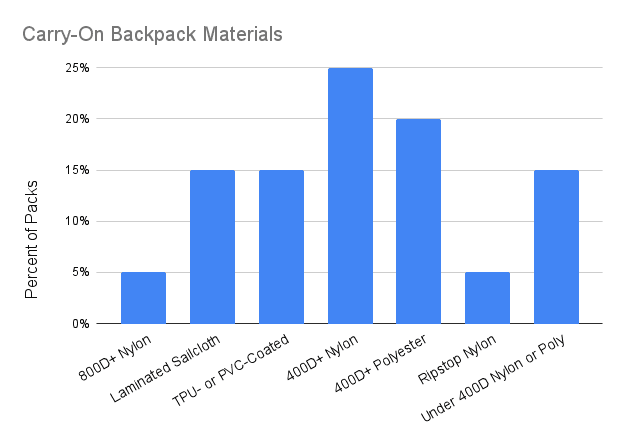
Everyday Backpack Statistics
Everyday backpacks are daypacks that are designed for commuting, work, school, and any other day-to-day activities. Many everyday bags are designed primarily as laptop backpacks, as that is a standard requirement in the modern world.
Everyday Backpack Volume
The vast majority of everyday bags have less than 30 L of volume. Any more than that is starting to encroach into travel backpack territory.
The average everyday backpack volume is 22.2 L, and 68% of everyday backpacks are between 16.0 L and 27.6 L.
|
Everyday Backpack Volume Statistics |
|
| Average |
22.2 L |
|
Median |
22.0 L |
| Standard Deviation |
5.4 L |
Everyday Backpack Weight
Most people don’t pay much attention to weight when choosing an everyday backpack. Very few everyday bags are overly heavy. Design and features are more important for everyday use than low weight.
The average weight for everyday backpacks is nearly a full pound lighter than travel backpacks: 2.5 lbs. This is primarily due to the smaller size, but everyday backpacks also often use lighter materials and have less structure and padding since they won’t be carrying as much weight.
|
Everyday Backpack Weight Statistics |
|
| Average |
2.5 lbs |
|
Median |
2.4 lbs |
| Standard Deviation |
0.9 lbs |
Everyday Backpack Prices
Everyday backpacks are significantly cheaper than travel backpacks, with an average price of $199.84 and a median price of $199.00. 68% of everyday packs are priced between $110.55 and $281.03. The most expensive daypack in our database is the Mission Workshop Rhake, which costs $545 in the X-Pac version.
|
Everyday Backpack Price Statistics |
|
| Average |
$199.84 |
|
Median |
$198.50 |
| Standard Deviation |
$81.29 |
Everyday Backpack Materials
Like travel backpacks, everyday backpacks are most often constructed from mid-weight nylon. There are also more everyday backpacks made from nylon or polyester with a thick TPU or PVC coating, which adds impressive water resistance and strength.
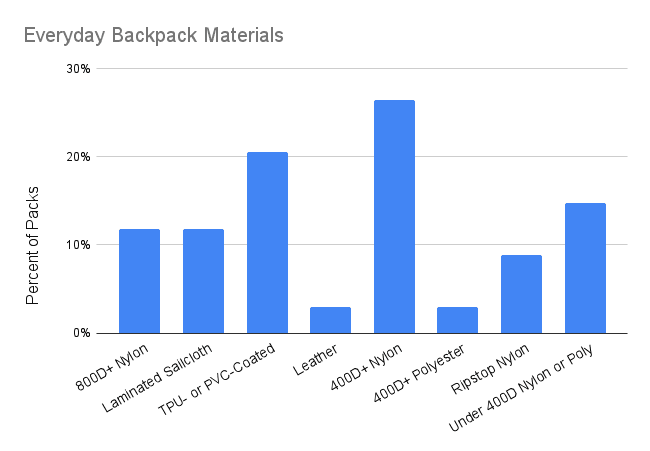
Hiking & Outdoor Backpack Statistics
Hiking and outdoor backpacks are technical pieces of gear that are designed to perform during a range of outdoor activities including hiking, running, backpacking, skiing, cycling, and more. These packs are often very specialized to a specific use case and range from ultralight vest packs for trail running to massive gear haulers for multi week excursions in the backcountry.
Hiking & Outdoor Backpack Volume
Since they are designed for so many different use cases, outdoor backpacks come in a huge range of volumes. It makes more sense to divide outdoor backpacks into two subcategories: daypacks and multi day packs.
Daypacks have an average of 22.6 L of volume, while multi-day backpacks are typically more than twice the size, with an average of 51.9 L of volume.
|
Hiking & Outdoor Backpack VolumeStatistics |
||
| Daypacks |
Multi-Day Packs |
|
|
Average |
22.4 L | 51.9 L |
| Median | 22 L |
55.0 L |
|
Standard Deviation |
3.6 L |
13.9 L |
Hiking & Outdoor Backpack Weight
Weight is a priority in the design of outdoor backpacks, which are often worn all day under demanding conditions. Many people look for the lightest pack possible that doesn’t compromise basic functions.
Outdoor daypacks are typically the lightest of any backpack category. The average outdoor daypack weight is 1.5 lbs—that’s over a full pound lighter than everyday daypacks. Hiking daypacks are designed to be minimal and streamlined and usually don’t have features like padded laptop sleeves or loads of organization pockets.
Because of their size, multi-day packs are significantly heavier—4.5 lbs on average. However, there is an entire niche of “ultralight” backpacking backs, which are under 2.5 lbs all the way down to a mere 14 oz. For example, the Z-Packs Arc Haul Ultra is a full-featured 50 L backpack that weighs a scant 1.3 lbs.
|
Hiking & Outdoor Backpack Weight Statistics |
||
| Daypacks |
Multi-Day Packs |
|
|
Average |
1.5 lbs | 4.5 lbs |
| Median | 1.4 lbs |
4.5 lbs |
|
Standard Deviation |
0.6 lbs |
1.8 lbs |
Hiking & Outdoor Backpack Prices
Outdoor backpacks also vary widely in price. Because of their simplicity, hiking daypacks are the least expensive category we analyzed, with an average price of $145.58. On the other end of the spectrum, multi-day packs are the most expensive.
|
Hiking & Outdoor Backpack Price Statistics |
||
| Daypacks |
Multi-Day Packs |
|
|
Average |
$145.58 | $289.81 |
| Median | $140.00 |
$320.00 |
|
Standard Deviation |
$80.85 |
$59.61 |
Hiking & Outdoor Backpack Materials
Hiking and outdoor backpacks are more uniform in the materials used than any other category. The vast majority use some form of ripstop nylon. The main reason for this is weight: ripstop nylon can be incredibly lightweight while maintaining good durability.
Some technical outdoor backpacks also incorporate more advanced materials like HMWPE (also known as Dyneema), which is stronger than steel and adds impressive durability. These bags come with a cost penalty, though.
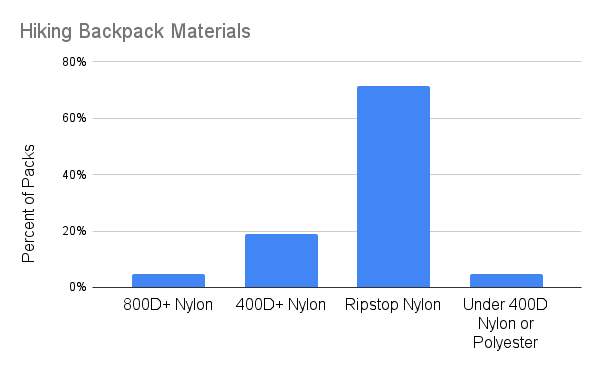
Backpack Statistics by Region
Backpack use and interest are not uniform around the globe. In some regions, backpacks are seen as daily necessities, while in other regions, they are unnecessary luxuries.
Here are the most important regional backpack statistics.
Google Search Interest in Backpacks by Region
Breaking down Google search volume for backpacks by region is an interesting way to compare the interest in backpacks between regions. This isn’t a perfect metric, but it shows how much people are searching for backpacks online.
Using Google Trends, I ranked the countries with the highest and lowest search interest for the term “backpack” in 2023.
Google rates search interest as a proportion of all searches. The region with the highest search interest gets a score of 100, and every other region’s score is a percentage of that (a score of 50 means half the search interest of the highest score). I excluded regions with low search volume for this study; that leaves 58 regions to consider.
The table below shows the 10 regions with the highest search interest for the term “backpack.”
|
Highest Search Interest by Region |
||
|
Rank |
Country | Search Interest |
| 1 | United States |
100 |
|
2 |
Singapore | 96 |
| 3 | Australia |
84 |
|
4 |
United Kingdom | 82 |
| 5 | Jamaica |
78 |
|
6 |
Canada | 72 |
| 7 | New Zealand |
68 |
|
8 |
Hong Kong | 60 |
| 9 | Ireland |
48 |
| 10 | Greece |
48 |
The table below shows the 10 regions with the lowest search interest for the term “backpack.”
|
Lowest Search Interest by Region |
||
| Rank | Country |
Search Interest |
|
1 |
Iran | 2 |
| 2 | Brazil |
2 |
|
3 |
Argentina | 2 |
| 4 | Colombia |
3 |
|
5 |
Turkey | 3 |
| 6 | Japan |
5 |
| 7 | Peru |
5 |
|
8 |
Ukraine | 5 |
| 9 | France |
6 |
| 10 | Russia |
6 |
The broad trend in the tables above is that more affluent countries have higher search interest in backpacks while developing countries have lower interest. This clearly isn’t a hard and fast rule, though. Jamaica is a less-developed nation that ranks 5th for the most backpack search interest. Japan and France are both very affluent, developed countries that rank in the lowest 10.
The overall trend makes sense, as people in wealthier countries have higher consumer spending overall and spend more on backpacks. However, there is no clear explanation for the exceptions. Why does Jamaica have a high interest in backpacks while Japan does not? This question requires further research.
Google Search Interest in Backpacks by State
There is also significant variance in interest in backpacks by state within the US. The map and table below show the ranking of the 50 states by backpack search interest.
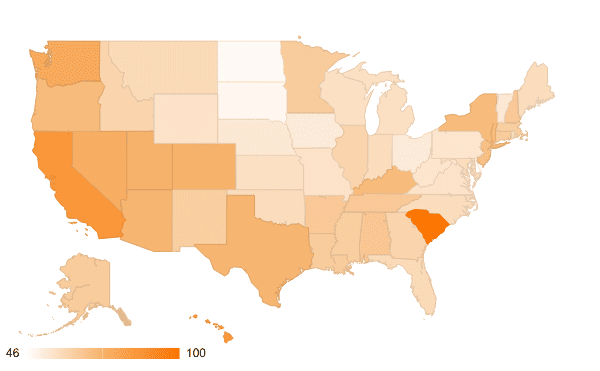
| “Backpack” Search Interest by State | ||
| Rank | State | Search Interest |
| 1 | South Carolina | 100 |
| 2 | California | 85 |
| 3 | Hawaii | 84 |
| 4 | Washington | 77 |
| 5 | Nevada | 75 |
| 6 | Utah | 73 |
| 7 | Colorado | 73 |
| 8 | Arizona | 72 |
| 9 | Texas | 72 |
| 10 | Oregon | 70 |
| 11 | New York | 70 |
| 12 | Kentucky | 70 |
| 13 | New Jersey | 68 |
| 14 | Alabama | 66 |
| 15 | Tennessee | 65 |
| 16 | New Hampshire | 65 |
| 17 | Arkansas | 65 |
| 18 | Louisiana | 64 |
| 19 | Connecticut | 64 |
| 20 | District of Columbia | 64 |
| 21 | Minnesota | 64 |
| 22 | Alaska | 64 |
| 23 | New Mexico | 63 |
| 24 | Massachusetts | 63 |
| 25 | Mississippi | 63 |
| 26 | Georgia | 61 |
| 27 | Illinois | 61 |
| 28 | Idaho | 61 |
| 29 | Florida | 59 |
| 30 | Montana | 59 |
| 31 | Indiana | 58 |
| 32 | Maryland | 58 |
| 33 | Rhode Island | 58 |
| 34 | North Carolina | 58 |
| 35 | Oklahoma | 58 |
| 36 | Maine | 58 |
| 37 | Wisconsin | 57 |
| 38 | Michigan | 57 |
| 39 | Kansas | 57 |
| 40 | Wyoming | 56 |
| 41 | Virginia | 56 |
| 42 | Missouri | 56 |
| 43 | West Virginia | 55 |
| 44 | Pennsylvania | 55 |
| 45 | Nebraska | 54 |
| 46 | Vermont | 54 |
| 47 | Ohio | 53 |
| 48 | Iowa | 53 |
| 49 | South Dakota | 49 |
| 50 | North Dakota | 48 |
| 51 | Delaware | 46 |
The Western US states have higher overall search interest in backpacks than the rest of the nation, while the Midwest Region has the lowest interest.
It is also notable that in the top 10 states for backpack search interest, there are several states that are famous for outdoor recreation: California, Hawaii, Washington, Utah, Colorado, Arizona, and Oregon.
It also makes sense that there is a high concentration of backpack and outdoor gear companies with headquarters in these states. Areas like Boulder, Portland, and Salt Lake City are hotspots for outdoor gear design.
Sources and Methodology
The data used in this report is divided into three categories: market data, search data, and product data.
The market data includes annual sales, global market size, and market growth forecasts. I collected this data from multiple sources, including Statista, IndustryArc, and The New York Times. I combined these individual data points and sets to get a more complete picture of the global backpack market.
Search data was collected using Google Trends. I used this tool to collect Google search statistics for the 2023 calendar year. I analyzed search results for the search term “backpack” and segmented out searches by country, state, and month. These search results serve as a proxy for public interest in backpacks, and are useful for measuring trends geographically or over time.
To collect product data, I used TravelFreak’s backpack rating database, which stores the metrics we use for reviewing and scoring backpacks. We store 44 distinct data points for every backpack in our database, which gives a wealth of information to draw from. The details in our product database come from our decades of in-depth research and testing.
I used this data to extract averages and statistical distributions for weight, volume, MSRP, and materials used across the different backpack categories.
Changelog
We periodically review this report, check for errors or inconsistencies, and update it with the most recent data. Here is the change history for this report.
- February 26, 2024—first published

